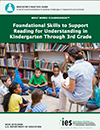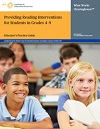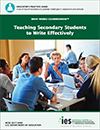The What Works Clearinghouse (WWC) at the Institute for Education Sciences (IES) publishes practice guides. A practice guide is a publication that presents recommendations for educators to address challenges in their classrooms and schools. They are based on reviews of research, the experiences of practitioners, and the expert opinions of a panel of nationally recognized experts. This page highlights the practice guides focused on language and literacy.
Click on the practice guide title to view the entire practice guide. Click on the arrow to expand and review its recommendations. Many recommendations include videos of instructional examples in the classroom.
Preparing Young Children for School
1
Regularly provide intentional, engaging instruction and practice focused on social-emotional skills.

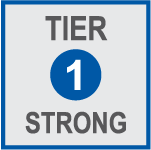
2
Strengthen children's executive function skills using specific games and activities.

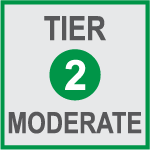
3
Provide intentional instruction to build children’s understanding of mathematical ideas and skills.


4
Engage children in conversations about mathematical ideas and support them in using mathematical language.


5
Intentionally plan activities to build children’s vocabulary and language.


See an instructional example in the classroom
Video 4: Play-Based Interactions with Teacher Guidance from IES.
This video depicts a preschool class engaging in play-based interactions intentionally planned by the teacher to build children's vocabulary and language (9:47).
Video 3: Engaging in Multiturn Conversations from IES.
This video shows a teacher and teacher assistant engaging preschool children in multiturn conversations throughout the day by restating, expanding, asking open-ended questions, and providing opportunities for peer-to-peer interactions (6:59).
6
Build children’s knowledge of letters and sounds.


See an instructional example in the classroom
Video 2: Small-Group Explicit Instruction Using Sound Bags (M and S) from IES.
This video shows a teacher explicitly teaching letters M and S to a small group of preschool children (6:00).
Video 8: Small-Group Explicit Instruction for the Letter M from IES.
This video shows a teacher explicitly teaching upper- and lowercase M with a small group of preschool children (4:13).
7
Use shared book reading to develop children’s language, knowledge of print features, and knowledge of the world.


See an instructional example in the classroom
Video 7: Print Referencing During Read Alouds from IES.
In this video, preschool children notice various aspects of print as the teacher makes verbal and nonverbal references during a read aloud (5:56).
Video 3: Dialogic Reading with Expository Text from IES.
This video shows clips of a preschool teacher across several days implementing Dialogic Reading to support vocabulary development (22:05).
Foundational Skills to Support Reading for Understanding in Kindergarten Through 3rd Grade
1
Teach students academic language skills, including the use of inferential and narrative language, and vocabulary knowledge.

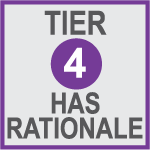
See an instructional example in the classroom
Video 1: Inferential Language, Read Aloud & Discussion from IES.
This video depicts a kindergarten class engaging in a read aloud and discussion (5:12).
Video 2: Inferential Language, Read Aloud & Discussion from IES.
This video depicts a third grade class engaging in a read aloud and discussion (5:24).
2
Develop awareness of the segments of sounds in speech and how they link to letters.


See an instructional example in the classroom
Video 15: Phonemes Linked to Letters from IES.
This video depicts a small group of first grade students engaging in a phonemes linked to letters activity using Elkonin boxes, manipulatives, and letter-tiles (4:52).
Video 18: Word Building from IES.
This video depicts a small group of first grade students engaging in a word-building activity using sound boxes and letter-tiles (5:45).
3
Teach students to decode words, analyze word parts, and write and recognize words.


See an instructional example in the classroom
Video 17: Letter–Sounds from IES.
This video depicts a whole group of K/1 students engaging in a phonemes linked to letters activity using letter-sound cards, mini-whiteboards, and markers (5:03).
Video 29: Decodable Words in Isolation and in Text from IES.
This video depicts a small group of first grade students engaging in a decodable words in isolation and in text activity using letter-cards and pocket charts (7:43).
4
Ensure that each student reads connected text every day to support reading accuracy, fluency, and comprehension.


See an instructional example in the classroom
Video 35: Partner Reading from IES.
This video depicts a second grade class engaging in a partner reading (3:04).
Improving Reading Comprehension in Kindergarten Through 3rd Grade
1
Teach students how to use reading comprehension strategies.

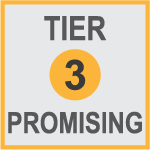
See an instructional example in the classroom
Video 4: Narrative Language, Prediction from IES.
This video depicts a kindergarten class engaging in a prediction activity using a narrative text (4:59).
Video 5: Narrative Language, Retell from IES.
Watch a first-grade class engaging in a retell activity using an expository text and a graphic organizer (5:14).
2
Teach students to identify and use the text’s organizational structure to comprehend, learn, and remember content.


See an instructional example in the classroom
Video 7: Narrative Language, Cause & Effect from IES.
This video shows a third-grade class engaging in a cause-and-effect activity using an expository text and a graphic organizer (7:12).
3
Guide students through focused, high-quality discussion on the meaning of text.


See an instructional example in the classroom
Video 2: Inferential Language, Read Aloud and Discussion from IES.
Watch a third-grade class engaging in a discussion about a text the teacher read aloud (5:24).
Video 9: Academic Vocabulary in Text from IES.
This video shows a second-grade class engaging in an academic vocabulary discussion about an expository text (6:53).
4
Select texts purposefully to support comprehension development.


Listen to an interview with an expert
Choosing the Right Text from IES.
Dr. Nell Duke discusses how to select the right text to support comprehension in kindergarten through third grade (5:13).
5
Establish an engaging and motivating context in which to teach reading comprehension.


Listen to an interview with an expert
Developing Student Motivation to Read from IES.
Dr. John Guthrie discusses how to establish an engaging and motivating context to support comprehension in kindergarten through third grade (5:39).
Assisting Students Struggling with Reading: Response to Intervention (RtI) and Multi-Tier Intervention in the Primary Grades
1
Screen all students for potential reading problems at the beginning of the year and again in the middle of the year.


Watch an animation
Overview of Universal Screening for All Students from IES.
This animation describes the process and importance of universal screen (6:17).
2
Provide time for differentiated reading instruction for all students based on assessments of students’ current reading level.


See an instructional example in the classroom
Video 29: Decodable Words in Isolation and in Text from IES.
This video shows a first-grade teacher differentiating instruction with a small group of students who needed extra instruction and practice with the long e sound represented by the sound-spelling patterns ea and ee (7:43). Throughout the lesson, the teacher helps students practice reading ea and ee in multiple kinds of activities and formats. Notice how students practice reading single words (0:54), word lists (3:11), and connected text (4:10), sometimes aloud with their peers and sometimes independently. Notice how the teacher also checks for each student’s understanding throughout the lesson, like when the group discussed the ee and ea words they found (5:10) and the sounds owls make (6:50) in the story.
3
Provide intensive, systematic instruction on up to three foundational reading skills in small groups to students who score below the benchmark score on universal screening.


See an instructional example in the classroom
Video 15: Phonemes Linked to Letters from IES.
This video shows a first-grade teacher providing intensive, systematic instruction in phonemic awareness, phonics, and decoding with a small group. Based on assessment, each student in this group needs more instruction and practice on these foundational reading skills (4:52).
4
Monitor the progress of tier 2 students at least once a month.


Listen to an interview with an expert
Progress Monitoring at Tier 2 from IES.
Dr. McDonald Connor describes why it is important to frequently monitor the progress of students in tier 2 (5:32).
5
Provide intensive instruction on a daily basis that promotes the development of the various components of reading proficiency to students who show minimal progress after reasonable time in tier 2 small group instruction (tier 3).


Listen to an interview with an expert
Intensive Tier 3 Instruction from IES.
Dr. Joe Dimino describes intensive tier 3 instruction, practice opportunities, and double dose (4:09).
Effective Literacy and English Language Instruction for English Learners in the Elementary Grades
1
Screen for reading problems and monitor progress.


2
Provide intensive small-group reading interventions.


3
Provide extensive and varied vocabulary instruction.


4
Develop academic English.


5
Schedule regular peer-assisted learning opportunities.


Teaching Academic Content and Literacy to English Learners in Elementary and Middle School
1
Teach a set of academic vocabulary words intensively across several days using a variety of instructional activities.


See an instructional example in the classroom
Pre-Teaching Vocabulary (second/third-grade combination) from IES.
A teacher in a second/third-grade combination class demonstrates how to teach academic vocabulary through the use of examples, non-examples, and concrete representations. The class shown has 20 students: 14 in second grade and 6 in third grade. The students have all been enrolled at this school since kindergarten. Over 75% of the students are English learners, and their primary language is Spanish. Of the students who speak Spanish, eight are at an intermediate level of English proficiency, while five are at an advanced level (3:02).
Activities to Promote Word Learning (second/third-grade combination) from IES.
In this video, a teacher in a second/third-grade combination class models how to provide activities that enable students to interact with words during the guided practice phase of a lesson. The class shown has 20 students: 14 in second grade and 6 in third grade. The students have all been enrolled at this school since kindergarten. Over 75% of the students are English learners, and their primary language is Spanish. Of the students who speak Spanish, eight are at an intermediate level of English proficiency, while five are at an advanced level (3:45).
2
Integrate oral and written English language instruction into content-area teaching.


See an instructional example in the classroom
Using Videos to Anchor Instruction (second-grade class) from IES.
A second-grade teacher demonstrates strategies to use before and after showing a video as a way to anchor instruction. The class has 26 students. Three are native English speakers; the rest are English learners whose home language is Spanish and whose English proficiency is in the intermediate range. The majority of the students were born in the United States and have been enrolled at this school since kindergarten. This teaching segment was filmed during the second month of school (7:06).
Completing a Graphic Organizer (second-grade class) from IES.
A second-grade teacher models how to lead a class in completing a graphic organizer of content presented in a video (see the video Using Videos to Anchor Instruction). The class shown has 26 students. Three are native English speakers; the rest are English learners whose home language is Spanish and whose English proficiency is in the intermediate range. The majority of the students were born in the United States and have been enrolled at this school since kindergarten. This teaching segment was filmed during the second month of school (5:45).
3
Provide regular, structured opportunities to develop written language skills.


See an instructional example in the classroom
Using Graphic Organizers in Writing (second-grade class) from IES.
A second-grade teacher demonstrates how to use a graphic organizer as the foundation of a writing assignment. The class has 26 students. Three are native English speakers; the rest are English learners whose home language is Spanish and whose English proficiency is in the intermediate range. The majority of the students were born in the United States and have been enrolled at this school since kindergarten. This teaching segment was filmed during the second month of school (6:31).
4
Provide small-group instructional intervention to students struggling in areas of literacy and English language development.


Listen to an interview with an expert
Introduction to Recommendation 4 from IES.
Joan Morris, a retired teacher specialist and a panel member for the English learner practice guide, presents a brief overview of Recommendation 4, including a description of the five How-to steps for carrying out the recommendation (5:59).
Teaching Elementary School Students to Be Effective Writers
1
Provide daily time for students to write.


Watch a narrated presentation
Provide Daily Time for Writing from IES.
This video discusses the importance of providing writing instruction and practice daily. It also discusses ways in which teachers can integrate writing instruction and practice into several subject areas (3:32).
2
Teach students to use the writing process for a variety of purposes.


Watch a narrated presentation
Teaching Students to Use the Writing Process for a Variety of Purposes from IES.
This video describes how teachers can help students become effective writers by teaching a variety of strategies for each component of the writing process and helping students apply the strategies until they are able to do so independently. The writing process is described as flexible and includes planning, drafting, sharing, evaluating, revising, editing, and publishing (8:59).
3
Teach students to become fluent with handwriting, spelling, sentence construction, typing, and word processing.


Watch a narrated presentation
Teaching Foundational Skills to Help Students Become Effective Writers from IES.
This video describes how to teach students foundational writing skills so that they can focus more on developing and communicating ideas in their writing. Handwriting, spelling, sentence construction, typing, and word processing should become effortless as students move to middle and upper elementary school. Younger students need explicit instruction and frequent practice to acquire and polish these skills (5:04).
4
Create an engaged community of writers.


See an instructional example in the classroom
Interactive Writing Instruction Online with Young Children from IES.
This video demonstrates how to facilitate a writing lesson with kindergarteners and first graders in a distance learning environment. Watch Professor Nell K. Duke from the University of Michigan as she implements interactive writing to teach children how to collaboratively write a letter using an online interactive whiteboard (2:41 - 16:30). The lesson and teaching strategies align with the evidence-based recommendations from this practice guide. In the introduction to the video, Professor Steve Graham, WWC Panel Guide Chair, briefly introduces this Practice Guide and related recommendations for instruction (17:32).
Providing Reading Interventions for Students in Grades 4-9
1
Build students' decoding skills so they can read complex multisyllabic words.


2
Provide purposeful fluency-building activities to help students read effortlessly.


3
Routinely use a set of comprehension-building practices to help students make sense of the text.
- Part 3A. Build students’ world and word knowledge so they can make sense of the text
- Part 3B. Consistently provide students with opportunities to ask and answer questions to better understand the text they read
- Part 3C. Teach students a routine for determining the gist of a short section of text
- Part 3D. Teach students to monitor their comprehension as they read


4
Provide students with opportunities to practice making sense of stretch text (i.e., challenging text) that will expose them to complex ideas and information.


Improving Adolescent Literacy: Effective Classroom and Intervention Practices
1
Provide explicit vocabulary instruction.


2
Provide direct and explicit comprehension strategy instruction.


3
Provide opportunities for extended discussion of text meaning and interpretation.


4
Increase student motivation and engagement in literacy learning.


5
Make available intensive and individualized interventions for struggling readers that can be provided by trained specialists.


Teaching Secondary Students to Write Effectively
1
Explicitly teach appropriate writing strategies using a Model-Practice-Reflect instructional cycle.


2
Integrate writing and reading to emphasize key writing features.


3
Use assessments of student writing to inform instruction and feedback.




